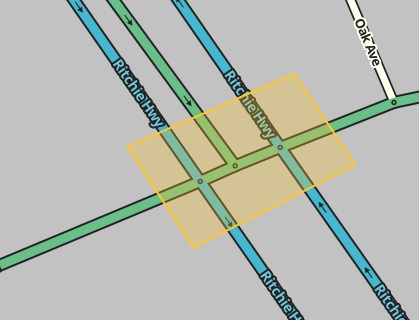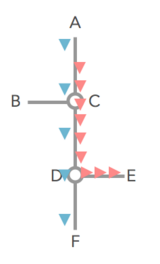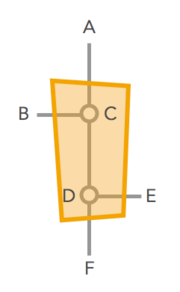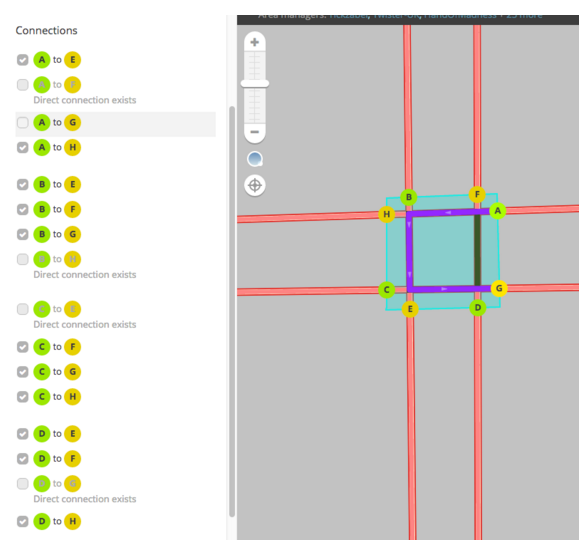Junction Box
Junction boxes are used to improve ETA calculations and routing through complicated intersections. Junction boxes are basically a hint editors can give the Waze routing services that “these few segments are split in a few places, but generally should be treated as a single point which switches traffic from several sources”. This hint helps the routing service get better ETA calculation and hence select better routes for Wazers.
Junction boxes are considered only by the routing server. Junction boxes have no visibility in the client or on the live map.
Effects Of Junction Box In Editor
Junction boxes can only be edited by editors of at least rank 5. Junction boxes appear in the Waze Map Editor when the Junctions layer ((add layer description to Map_editor_interface#Layers)) is turned on. Junction boxes appear as a box around all the junction nodes of an intersection.

All segments that enter the junction box are locked. Selecting a segment that is part of a junction box results in a message: "You cannot edit this segment. This segment is part of a junction and cannot be edited. Delete the junction to edit it."
Selecting the junction box causes the left pane to display the junction box properties.

Each entrance to the junction box is labeled with a letter in a green circle. Each exit from the junction box is labeled with a letter in yellow circle. Hovering the cursor over the letter circle will show the routes through the junction box that use the selected entrance or exit. The left pane shows each potential entrance/exit pair with a check box ticked for each pair enabled for routing. Routes through the junction box that pass through a single junction node are not considered. Such routes are controlled by turn restriction in place when the junction box is created. Thus the route from A to G is controlled by a turn restriction and does not show in the list of entrance/exit pairs. Routes through the junction box that are prohibited by turn restrictions in place when the junction box is created are not considered. In the above example, the left turns from southbound Ritchie Hwy use the dedicated turn lane. The left turn from the main lanes of southbound Ritchie Hwy to Pasadena Rd is restricted by an existing turn restriction. Thus, the junction box does not consider routes from southbound Ritchie Hwy to exits G or H. As routes from southbound Ritchie Hwy to exits E and F pass through only a single junction node, they are not considered in the junction box. The junction box thus considers no routes for the traffic entering from the main lanes of southbound Ritchie Hwy. For this reason, this entrance is not lettered.
Editing Junction Boxes
Junction boxes are created by selecting Junction box from the draw segments menu (Shortcut key J). Click at one vertex of the junction box. Continue click to at each vertex of the box until the box surrounds all the junctions nodes of the intersection. Double click to complete the box. When the junction box is selected, the left pane will show the potential contention paths through the junction box as illustrated above. Clicking the check box next to each connection path toggles between enabling or disabling routing between the indicated entrance/exit pair.
Before creating a junction box at an intersection, make sure that there are no incorrect turn restrictions. Routes through the junction box that are prevented by existing turn restrictions cannot be enabled in the junction box.
Function Of Junction Box
The junction box enables a complex intersection composed and displayed as multiple segments to be treated as single junction node with multiple inputs and outputs. Considering a complex intersection a single point has several beneficial properties. Traffic speed data from each path through the intersection can be collected separately. Turn restrictions can also be separately controlled for each path through the intersection.
Improving Data Collection
Junction boxes can be used to improve routing through complex intersections. The geometry of segments and nodes inside is eliminated from consideration for ETA calculations. Take the following intersection for example:
Assume that all the roads are two-way and all turns are enabled. Consider the drivers going from A to E and from A to F when there is a traffic jam for the left turn (at point D) but traffic going straight through D is flowing fine.
Without the junction box, the traffic from point A to point C is considered to be the same for both the red and the blue cars. The same statistical data is gathered and and the average speed skews the ETA for everyone.
The junction box solves this problem.
With the junction box, historical and real time data are collected separately for each one of the possible routes through the intersection - all 12 of them.
Thus, URs resulting from the inability to distinguish left turn delays from straight through traffic can be dealt with using the junction box.

Controlling Turns
Junction boxes permit disabling turns that are difficult to control in complex intersections. Without a junction box, controlling turns requires adding artificial segments or reducing the intersection to a point using a bow-tie configuration. Take the example of the intersection of two divided highways. It is difficult to enable U-turns in one direction, while allowing left turns and the U-turn in the other direction. Such an intersection can be configured with a junction box to control each turn.
With the junction box, the turn from U-turn from A to G can be disabled while still allowing the left turn from A to E.
When To Use A Junction Box
Junction boxes are suitable only for specific locations where the above listed functions of junctions boxes are required. If problems with data collection or turn restrictions are experienced then a junction box may be use to solve the problem.
Junction boxes require more space to store all the data involved. The routing server takes longer to analyse junction boxes and thus to provide routes through junction boxes. For these reasons, junction boxes should not be used for every intersection.



